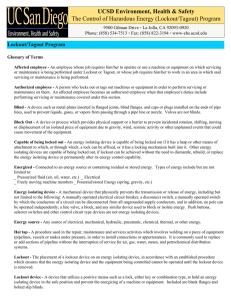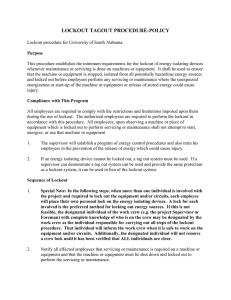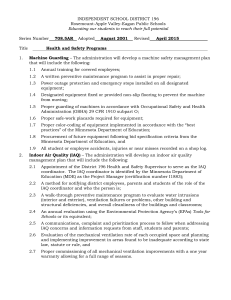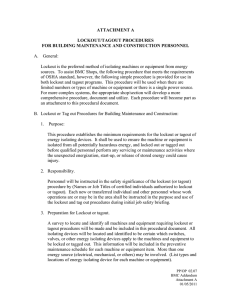Hazardous Energy Control Procedures "Lockout/Tagout" REDWOODS COMMUNITY COLLEGE DISTRICT
advertisement
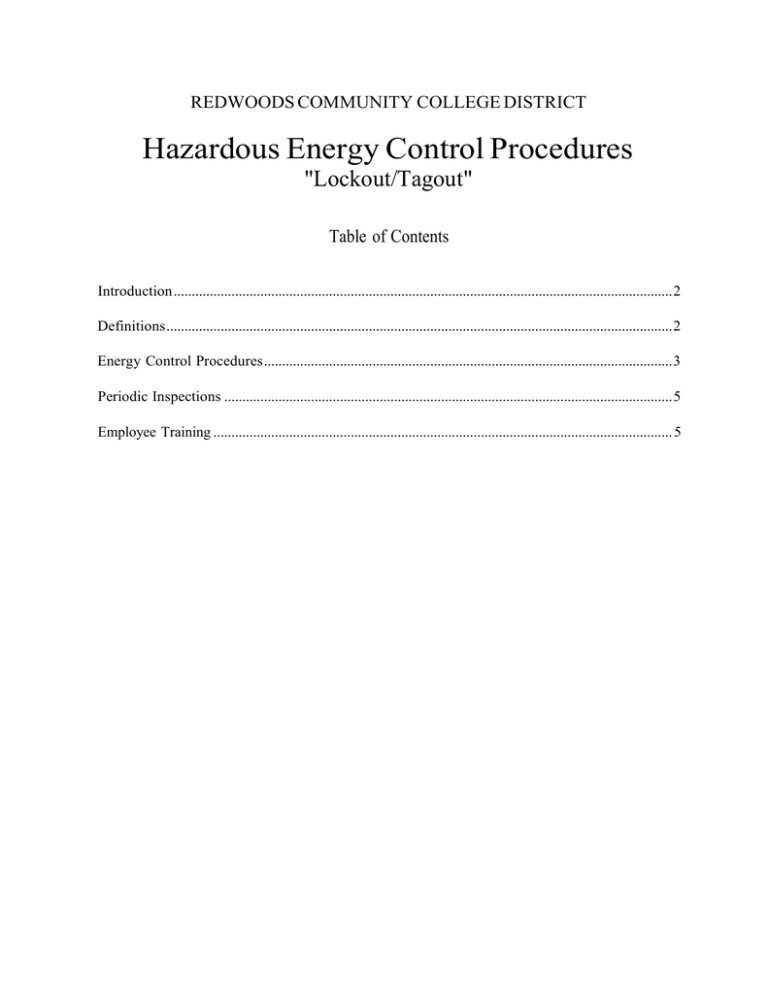
REDWOODS COMMUNITY COLLEGE DISTRICT Hazardous Energy Control Procedures "Lockout/Tagout" Table of Contents Introduction .......................................................................................................................................... 2 Definitions ............................................................................................................................................ 2 Energy Control Procedures ................................................................................................................. 3 Periodic Inspections ............................................................................................................................ 5 Employee Training ............................................................................................................................... 5 Introduction The District's Hazardous Energy Control Procedures, "Lock/Tagout," is one of a series of plans and procedures developed to provide for the safety of employees, students and the public. The procedures identified in this plan establish the minimum requirements for the lockout/tagout of energy sources of equipment or machines. The following procedures shall be used to ensure equipment or machines are stopped, isolated from all potentially hazardous energy sources, and locked and/or tagged out before employees perform any servicing, adjustments, or maintenance where the unexpected activation, movement, or start-up of the machine(s), equipment, or release of stored energy could cause injury. All employees of the District are required to comply with the procedures, restrictions, and limitations provided for in this plan. Authorized employees are required to perform lockout/tagout in accordance with the procedures identified in this plan. All affected employees, upon observing machine(s) or equipment which are locked-out or tagged-out for the performance of servicing or maintenance shall not attempt to start, energize or use the machine(s) or equipment. This plan is written in compliance with 8 CCR 3314. Whenever outside servicing personnel are to be engaged in activities covered by the District's plan the District's Lockout/Tagout Plan shall be followed. Definitions Affected employee - an employee whose job requires him/her to operate or use a machine or equipment on which servicing or maintenance is being performed under lockout/tagout, or whose job requires him/her to work in an area in which such maintenance is being performed. Authorized employee - an employee who locks or implements a tagout system procedure on machines or equipment to perform the servicing or maintenance on that machine or equipment. Energized- connected to an energy source or containing residual or stored energy. Lockout- the placement of a lockout device (usually a lock) on an energy isolating device, in accordance with an established procedure, ensuring that the energy isolating device and the equipment be controlled cannot be operated until the lockout device is removed. Tagout- the placement of a warning tag on an energy isolating device, to indicate that the energy isolating device and the equipment being controlled may not be operated until the tagout device is removed. 2 Energy Control Procedures Employees authorized to perform lockout/tagout shall be certain as to which switch, valve, or other energy isolating devices apply to the equipment or machine being locked or tagged out. More than one energy source (electrical, mechanical, hydraulic, pneumatic, gravity) may be involved. Any questionable identification of energy sources shall be cleared by the employee with their supervisor. Before lockout/tagout commences job authorization should be obtained. Lockout: Tagout: Every machine or piece of equipment equipped with lockable controls or readily adaptable to lockable controls shall be locked out or positively sealed in the "off' position before any servicing, maintenance, or setup work is performed on the equipment according to the following sequence: 1. Notify all affected employees that a lockout is required and the reason therefor. 2. If the equipment is operating, shut it down by the normal stopping procedure. 3. Operate the switch, valve, or other energy isolating devices so that the energy source(s) is disconnected or isolated from the equipment. Stored energy, such as that in capacitors; springs; elevated machine parts; rotating flywheels; hydraulic systems; and air, gas, steam, or water pressure; etc. must be dissipated or restrained by methods such as grounding, repositioning, blocking, bleed down, etc. 4. Lockout energy isolating devices with an assigned individual lock. 5. After ensuring that no personnel are exposed and as a check on having disconnected the energy source(s), operate the normal operating controls to make certain the equipment will not operate. CAUTION: Return operating controls to off or neutral position after the test. 6. The equipment is now locked out. Lockout is a surer means of assuring de-energizing of equipment than tagout, and lockout is the preferred method for use within the District. However, tagout will be used when the following conditions exist: 1. The energy control device will not accept a lockout device. 2. On repetitive process machines, such as numerical control machines, which require power or current continuance to maintain indexing. 3 3. On machines where repair, adjustment, testing or set up operations cannot be accomplished with the energy source locked out. Tagout is highly dependent upon human factors, and requires constant vigilance to ensure that tagout devices are not ignored. Where tagout is the only means of assuring the safety of personnel the following procedural sequence will be followed: 1. Notify all affected employees that a tagout is required and the reason thereof. 2. The operating station where the machine may be activated must at all times be under the control of a qualified operator or craftsperson. All participants must be in clear view of the operator or in positive communication with each other. 3. If the equipment is operating shut it down by the normal stopping procedure to the lowest level of energizing that will allow the necessary work to be performed. 4. Apply tagout notices in conspicuous locations at the operating and/or controlling stations. 5. All participants must be beyond the reach of machine elements which may move rapidly and present a hazard to them. Restoring Equipment to Service: After service or maintenance has been performed and equipment is ready for testing or return to service check the area to see that no one is exposed. When equipment is clear remove all locks and/or tags. Procedures Involving More than One Person: In the preceding steps for lockout or tagout, if more than one individual is required to work on the machine or equipment, each shall install their own lock and/or tag on the energy isolation device(s). The authorized employee who affixes a lockout or tagout device is the only one allowed to remove it. Each employee must have the assurance that the device in his/her control. If equipment operations continue across work shifts, then the equipment lockout/tagout continues in place. As each new participant begins he/she attaches his/her lock and/or tag such that the lockout/tagout status continues without interruption. As participants go off-shift they remove their lock and/or tag as new participants locks and tags are added. If a participant who is leaving expects to return their lock and/or tag remains in place. 4 Periodic Inspections To assure the energy control procedures remain viable and effective, and to assure the procedures are being followed, the District will provide for an annual inspection of the plan and procedures. The inspection will be carried out by the Coordinator, Environmental & Safety or other District employee who does not actually utilize the energy control procedure. The periodic inspections will be conducted in a manner to identify and correct any variations or inadequacies identified. The inspection will include a review of procedures and a review with each authorized employee of his/her responsibilities under energy control procedures. Employee Training Each employee authorized to work on equipment for set-up, maintenance, installation or other reason, shall receive training on lockout/tagout (energy control) procedures. Training will consist of the following: • Purpose and use of energy control procedures • Review of District energy control procedures • Recognition of applicable hazardous energy sources • Identification of types and magnitude of energy sources in the workplace • Methods and means of energy isolation and control • Limitations of tagout All training will be conducted and documented in accordance with the District's Injury & Illness Prevention Program. Last Reviewed: June 2015 5
